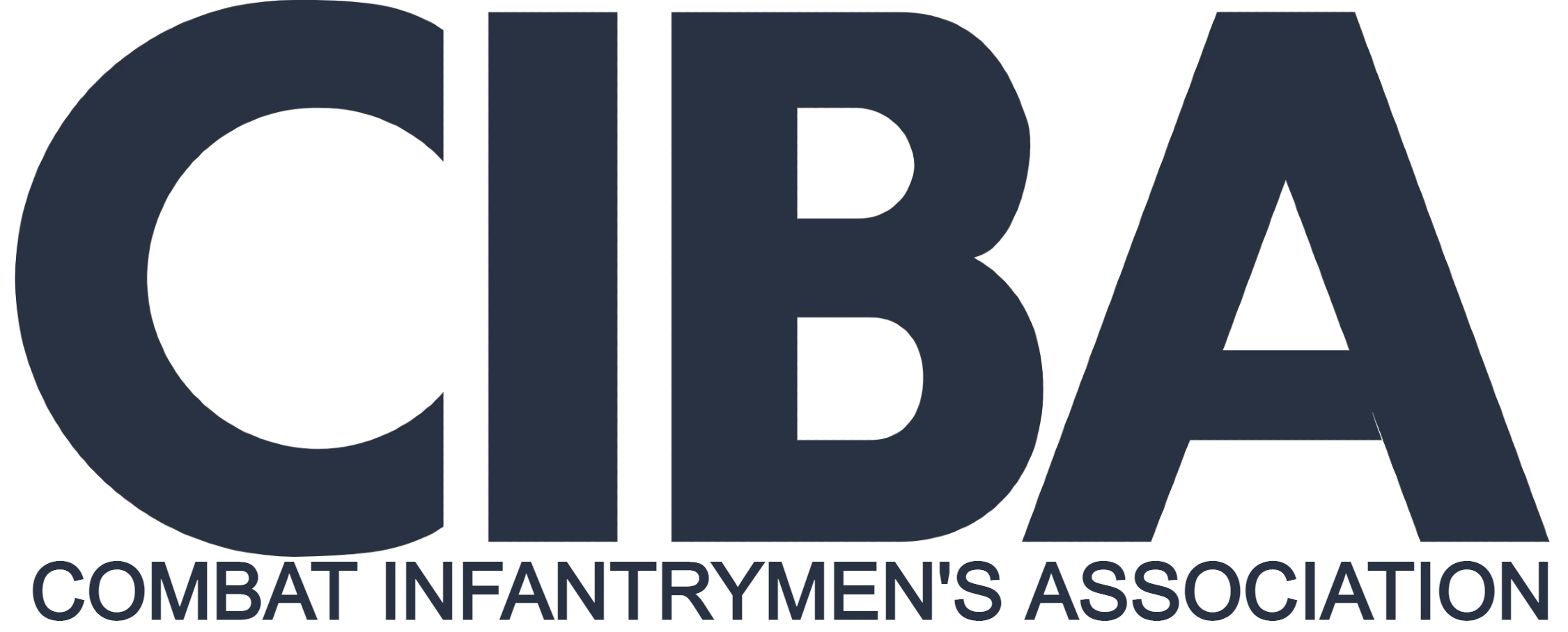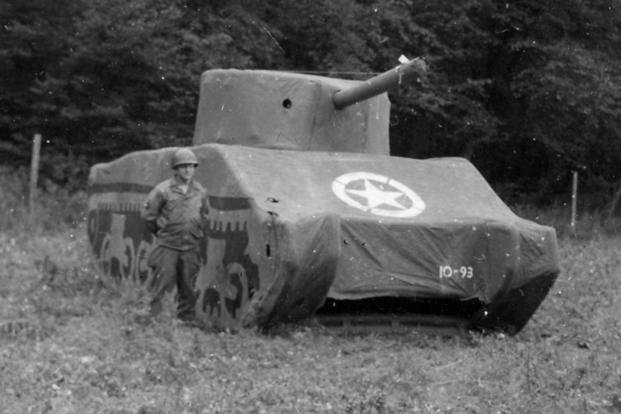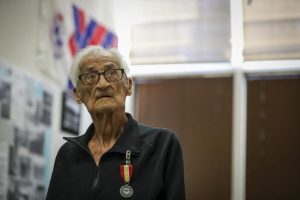All warfare is based on deception, Chinese strategist Sun Tzu once said.
The battlefield flimflam practiced by the Army’s top-secret 23rd Headquarters Special Troops unit during World War II took that ancient advice to another level as the “Ghost Army” in the drive to liberate Europe.
From D-Day to the crossing of the Rhine, the 23rd used inflatable tanks, trucks and artillery pieces; bogus radio traffic; 500-pound loudspeakers blasting recordings of divisions on the move; and other means of fakery to confuse the Nazis. In the process, it may have saved the lives of 15,000 to 30,000 American troops, according to Army historians.
Read Next: VA Paid Roughly $1 Million in Double Housing Payments to Some Student Vets Due to a Legal Loophole
Now, the unit is set to receive the Congressional Gold Medal, the highest honor Congress can bestow, at a March 21 ceremony on Capitol Hill. The medal was also awarded to a sister unit of the 23rd — the 3133rd Signal Service Company — which served in Italy and carried out two deception operations in 1945 near the end of the war.
President Joe Biden signed the “Ghost Army Congressional Gold Medal Act” in February 2022, but the commemorative coin had yet to be minted. It will be presented to the fewer than 10 surviving Ghost Army members at the ceremony.
“What made the Ghost Army special was not just their extraordinary courage, but their creativity,” Rep. Annie Kuster, D-N.H., sponsor of the House bill that authorized the medal, said in a statement.
A U.S. Army analysis cited in the text of the bill awarding the medal stated, “Rarely, if ever, has there been a group of such a few men which had so great an influence on the outcome of a major military campaign.”
Another tactic used by the 23rd was to have troops dress up as generals and go into towns that had just been taken to brag of the Army’s next moves in hopes that German spies would pick up on the false information.
The 93-pound inflatable versions of M4 Sherman tanks, which could weigh up to 42 tons, were the prize decoys for the 23rd and at a distance were nearly indistinguishable from the real thing.
Then-Pvt. Arthur Shilstone told of his encounter with two Frenchmen on bicycles who watched dumbfounded as four troops from the 23rd hoisted one of the inflatable Shermans on their shoulders to move it to another spot.
Shilstone, an acclaimed illustrator and watercolor artist who did album covers for Billie Holiday and Aaron Copland after the war, told Smithsonian magazine that the Frenchmen “looked at me, and they were looking for answers, and I finally said: ‘The Americans are very strong.'”
Gen. George Patton was quick to realize the advantage that the skills of the 23rd, which came to be known as the “Ghost Army,” would give him in disguising where his Third Army would attack.
In September 1944, Patton called on the 23rd to use their deception techniques to plug a gap in his lines in the attack on the fortified city of Metz.
In a letter to his wife, Patton wrote, “There is one rather bad spot in my line but I don’t think the Huns [Germans] know it,” an apparent reference to the effectiveness of the efforts by the 23rd, said Rick Beyer, president of the Ghost Army Legacy Project, who produced a PBS documentary and a book with Elizabeth Sayles called “The Ghost Army of World War II” on the unit’s exploits.
Patton again used the 23rd in December 1944 to create bogus radio traffic to mask the Third Army’s race “to break through to the 101st Airborne and elements of 10th Armored Division in the besieged Belgian town of Bastogne,” according to the text of the bill awarding the Congressional Gold Medal to the 23rd.
The Ghost Army was not part of Operation Fortitude South, in which the fictitious First United States Army Group was stationed in southeast England under Patton to convince the Germans that the D-Day landings would be at the Pas-de-Calais across from the Strait of Dover rather than in Normandy.
Instead, a small contingent of the 23rd went ashore in the D-Day landings in an attempt to create false landing sites, and two members were wounded. The unit would go on to conduct 21 more tactical deception operations in France, Luxembourg, Belgium and Germany.
The last and possibly most important mission for the 23rd was called Operation Viersen in March 1945, when the 23rd conducted a massive tactical deception and drew German forces down the Rhine River and away from the U.S. Ninth Army, allowing the Ninth Army to cross the Rhine into Germany.
The 23rd used more than 600 inflatable vehicles to carry off the ruse in Operation Viersen, and also used fabricated radio networks and soundtracks of artillery fire. According to a military intelligence officer with the 79th Infantry, “There is no doubt that Operation Viersen materially assisted in deceiving the enemy with regard to the real dispositions and intentions of this Army,” the text of the Gold Medal bill said.
The 23rd was activated in January 1944 and came to include about 1,100 enlisted troops and 82 officers, who had the sole mission of deceiving German forces — the first unit in the U.S. Army with such a mission — according to the National World War II Museum in New Orleans.
The troops of the Ghost Army were an eclectic mix, including designer Bill Blass, artist Ellsworth Kelly and photographer Art Kane, who were recruited from art schools, advertising agencies and communications companies.
Blass, who went on to design dresses for Jacqueline Kennedy and Nancy Reagan, was said to read Vogue magazine in his foxhole. In his autobiography titled “Bare Blass,” he said that “I spent most of the war inflating dummy tanks and dreaming up marvelous new uses for chicken feathers.”
Capt. Fred Fox, who wrote an official history of the 23rd cited by the Ghost Army Legacy Project, noted that newcomers to the unit could face a difficult period of adjustment.
“Officers who had once commanded 32-ton tanks felt frustrated and helpless with a battalion of rubber M4s — 93 pounds fully inflated,” Fox wrote. “The adjustment from man of action to man of wile was most difficult. Few realized at first that one could spend just as much energy pretending to flight as actually fighting.”
Little was known of the existence of the Ghost Army or its exploits for nearly 50 years after the war. The troops were sworn to secrecy, and its records were classified as top secret. A Smithsonian magazine article in 1985 was the first to give a limited account, but the records were not declassified until 1996, according to the Ghost Army Legacy Project.
“We were told we couldn’t tell our wives or anybody about what we did,” Al Albrecht, who served as a private in the 23rd, said in a video for the Ghost Army Legacy Project.
In the same video, Sgt. Stan Nance, who served with the 23rd’s radio unit, summed up what he viewed as the bedrock mission behind all the battlefield illusions: “If one mother or one new bride was spared the agony of putting a Gold Star in their front window — that’s what the 23rd was all about.”
Related: Larry Doby, World War II Navy Veteran Who Helped Integrate Baseball, Awarded Congressional Gold Medal
Story Continues
Please rate this CIBA article
Vote






